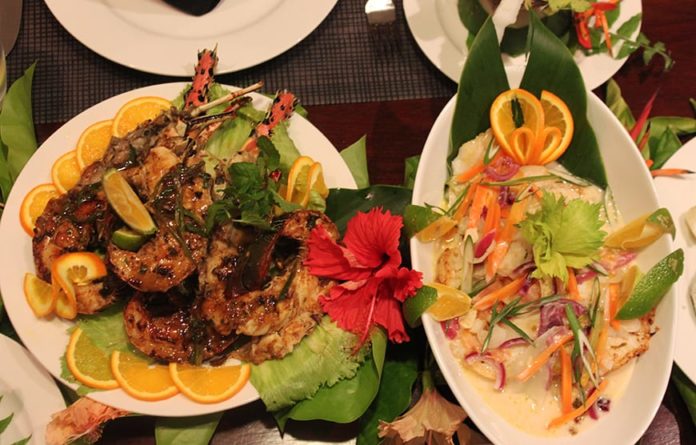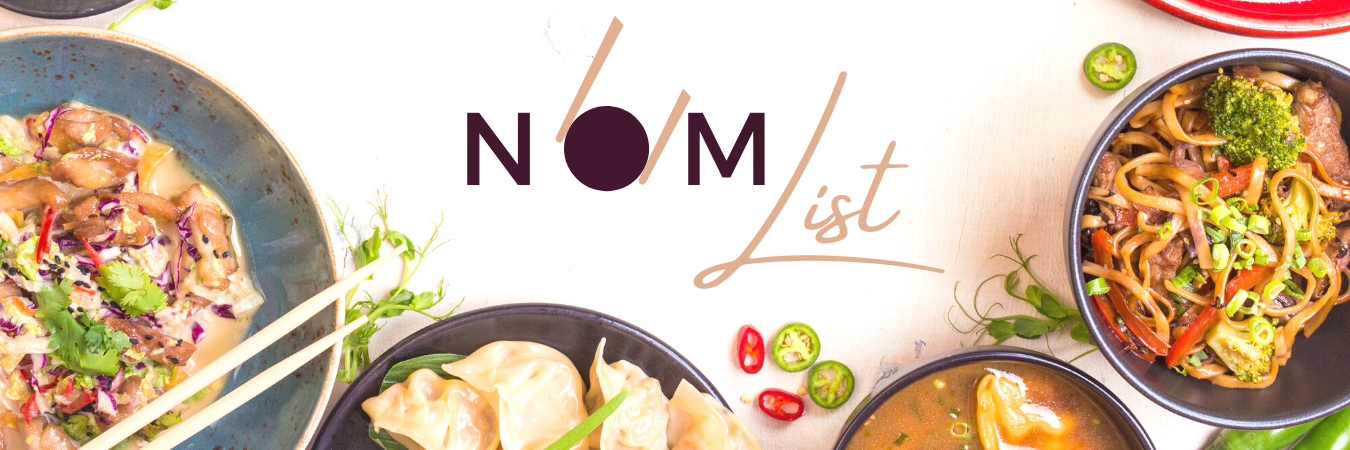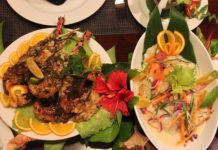
Fiji, known for its pristine beaches and vibrant culture, also boasts a rich traditional culinary scene. Fijian recipes are full of diverse flavors, incorporating ingredients from the islands as well as influences from Indian, Chinese, and other Pacific Islander cuisines. From delicious seafood dishes to mouth-watering vegetarian fare, Fiji offers a wide array of culinary delights that reflect the unique culture and traditions of the country.
One of the most popular Fijian dishes is kokoda, a raw fish salad marinated in lime and lemon juices, reminiscent of Hawaii’s poke and Peru’s ceviche. Another traditional dish, Fijian chicken palau, is a flavorful rice dish made with chicken and an aromatic blend of spices. Vegetarian options are abundant as well, with dishes like urdhi dhal, black dhal made with ghee, showcasing Fiji’s Indian culinary influence.
These traditional Fijian recipes provide a taste of the islands that one can recreate at home. Using locally sourced ingredients and techniques passed down for generations, these dishes not only showcase the flavors of Fiji but also offer insight into the island nation’s unique history and culture.
Fijian Cuisine Overview
South Pacific Influences
Fijian cuisine is an eclectic mix of flavors and techniques derived from its location in the South Pacific region. Traditional Fiji food shares similarities with other island nations such as New Zealand and Samoa, with a focus on fresh seafood, tropical fruits, and locally grown vegetables. The warm climate of Oceania allows for an abundance of produce and seafood to create unique and delicious dishes that showcase the natural bounty of the region.
Unique Fijian Flavors
A distinct characteristic of Fijian cuisine is the use of coconut, both as a cooking ingredient and as a flavoring. Coconut milk is often used to add richness and creaminess to dishes, while freshly grated coconut adds texture and a hint of sweetness. Another unique aspect of Fijian cooking is the use of spices and herbs. Fijian food is known for its bold flavors and aromatic spices such as ginger, garlic, and chili peppers.
Indigenous and Immigrant Contributions
The indigenous people of Fiji have a long history of contributing to the development of Fijian cuisine. Some traditional techniques, such as cooking in earth ovens or using naturally available ingredients like taro leaves, are still prevalent in modern Fijian cooking. However, the presence of immigrant populations in Fiji has also contributed to the fusion of flavors and cooking styles seen in Fijian cuisine.
Chinese immigrants, for example, have brought techniques such as stir-frying and the use of soy sauce to Fijian cooking. Indian influences are also evident in dishes like curry and the popular Fijian roti. The blending of these diverse culinary traditions over time has created a unique and flavorful cuisine that represents the various elements of Fiji’s multiethnic society.
Popular Ingredients in Fiji Recipes
Fiji is known for its delicious cuisine, which is primarily made using locally sourced ingredients. In this section, we will explore some of the popular ingredients found in Fiji recipes: Coconuts and Coconut Milk, Taro and Cassava, Fresh Fish and Seafood, and Herbs and Spices.
Coconuts and Coconut Milk
Coconuts are a staple ingredient in the Fijian diet, as they are abundant and versatile. They’re used in both sweet and savory dishes, providing a rich, creamy texture and unique flavor. Coconut milk is often used in Fijian dishes like Kokoda, a raw fish salad, and curry recipes, such as Fijian Chicken Curry, where it’s combined with spices to create a luscious sauce. In desserts, coconut milk or cream is used in treats like Cassava Cake and Palusami, a dessert made with taro leaves and coconut cream.
Taro and Cassava
Taro and cassava are two essential root vegetables in the Fijian diet, often consumed as a starch alternative to rice. Taro, a tropical root vegetable, is commonly used in dishes like boiled taro, Rourou (taro leaves cooked in coconut milk), and traditional Lovo feasts, where it is slow-cooked in an underground oven. Cassava, on the other hand, is a starchy shrub that’s often used in dishes like Cassava Cake, fried cassava, and other meals as a side.
Fresh Fish and Seafood
Fish and seafood play a significant role in the Fijian diet, as the island nation is surrounded by the ocean. Locals have access to fresh fish like Snapper, Mahi Mahi, and various shellfish, such as crabs and lobsters. Fiji recipes often include fish, such as Fish Suruwa, a fish curry flavored with tomatoes, onions, and spices. Seafood dishes like Mud Crab Curry and octopus-based meals are also popular in Fiji.
Herbs and Spices
Herbs and spices are essential to Fijian cuisine, adding vibrant flavors and depth to various dishes. Some commonly used spices include cumin, turmeric, chilies, black pepper, and curry powder, which are often used to create dishes like Fiji Masala or combined with coconut milk for curries. Fresh herbs like cilantro, spring onions, and coriander are also widely used in Fijian dishes, lending bright, aromatic flavors. In addition to these spices, Fiji recipes may also include garlic, ginger, mustard seeds, fenugreek, curry leaves, and cardamom to create a rich and flavorful meal.
Fiji food showcases a delightful blend of fresh, tropical ingredients and enticing spices, offering a unique culinary experience. By using these popular ingredients, one can recreate the taste of Fiji in their own kitchen, while celebrating the culture and simplicity of traditional Fijian cooking.
Traditional Fiji Recipes
Fijian Chicken Curry
Fijian Chicken Curry is a popular dish in Fiji, made with tender chicken pieces cooked in a rich and flavorful curry sauce. Typical ingredients include curry powder, mustard seeds, fenugreek, curry leaves, and cardamom. The chicken is often marinated in spices, then cooked with onions, tomatoes, and coconut milk to create a creamy and aromatic curry.
Kokoda
Kokoda is a traditional Fijian raw fish salad, similar to Hawaii’s poke and Peru’s ceviche. Raw fish, usually tuna or reef fish, is marinated in lime and lemon juices until the fish becomes opaque. The dish is then mixed with diced tomatoes, spring onions, cilantro, and coconut milk, resulting in a refreshing and citrusy appetizer.
Fish Suruwa
Fish Suruwa is a Fijian-style fish curry made with fresh fish fillets, such as snapper or grouper, cooked in a coconut milk-based sauce with tomatoes, onions, and spices, like mustard seed, fenugreek, and curry leaves. The dish is often served with a side of steamed rice or taro.
Rourou
Rourou, also known as dalo leaves, is a traditional Fijian dish made from taro leaves cooked with coconut milk, onions, garlic, and chili. The taro leaves are often steamed or boiled until tender, then mixed with the remaining ingredients to create a rich and creamy side dish. This dish is a staple in Fijian cuisine.
Duruka and Nama
Duruka is the unopened flower of a sugar cane plant, often referred to as Fijian asparagus or Pacific asparagus. Duruka is typically cooked with Nama, which are sea grapes, a type of seaweed. The dish is prepared by cooking duruka in coconut milk, mixed with Nama, onions, tomatoes, and aromatic herbs.
Palusami and Cassava Cake
Palusami is a beloved Fijian specialty made from taro leaves, which are used to wrap a mixture of onions, tomatoes, and coconut milk. The wrapped taro leaves are then roasted in an underground oven known as a Lovo. Cassava Cake, a popular dessert, is made from grated cassava mixed with sugar and coconut milk, then baked until golden brown.
Roti and Fiji Masala
Roti is a traditional Fijian flatbread, made with flour, water and a pinch of salt, and cooked on a hot griddle until soft and slightly charred. It is often served alongside flavorful Fiji Masala, a spice blend made with roasted and ground coriander, cumin, fennel seeds, and fenugreek. This combination makes for a tasty and enjoyable meal in Fiji.
Contemporary Fijian Cuisine
Influence of Tourism
In recent years, Fiji’s pristine beaches and beautiful nature have attracted tourists from all around the globe. This influx of tourism has a notable impact on Fijian cuisine, as local chefs create dishes that cater to the diverse tastes of international visitors. The consistent availability of fresh seafood in Fiji has enabled the development of mouth-watering dishes that showcase the island’s abundant marine life. Restaurants near popular beach destinations often offer a wide variety of seafood options, such as grilled fish and succulent prawns, enticing with their flavorful preparation and presentation.
Fusion of Cultures
As a melting pot of various cultures, Fiji has seen elements of Indian, Chinese, and European influences in its food. This fusion of cultures has resulted in a continually evolving cuisine, blending the traditional ingredients and techniques with new flavors, spices, and recipes. An example of this melding of traditions is the introduction of corned beef into Fijian dishes, a result of European contact. Corned beef, once considered a luxury product, has now become a staple in many Fijian households, and it’s commonly prepared in various forms, such as curries and stir-fries.
Adapting Traditional Recipes
While embracing contemporary techniques and diverse flavors, Fijian chefs are also finding innovative ways to adapt traditional recipes, ensuring that the essence of Fijian cuisine remains intact. The use of local produce like taro, cassava, and coconuts as bases for new dishes engages with the familiar flavors enjoyed for generations, while also exploring exciting culinary possibilities.
One example of adapting traditional recipes is the popular dish Kokoda, where fish is marinated in citrus juice and coconut cream, then served cold. Modern interpretations may incorporate additional ingredients or experiment with different types of fish, yet the essence of Kokoda remains rooted in Fijian tradition. Through innovation and adaptation, contemporary Fijian cuisine continues to captivate palates, while celebrating the rich cultural heritage of the island nation.
Fiji’s Culinary Landscape
Dining in Fiji
Fiji’s culinary scene offers a rich blend of traditional Fijian, Indian, Chinese, and European influences. It is steeped in history and known for its fresh ingredients, including seafood and locally grown produce. Visitors can enjoy a variety of dishes, including Fiji’s famous Kokoda, a raw fish dish marinated in lime or lemon juice, coconut cream, onions, and chilies.
Aside from the local delicacies, international cuisine is also widely available in Fiji. Many restaurants offer a range of dishes from different cultural influences, making dining in Fiji a truly diverse and satisfying experience.
Market and Street Food
Fiji’s markets are a treasure trove of local and regional produce, giving visitors a chance to experience an array of authentic Fijian flavors. At the markets, you can find a variety of traditional street foods to sample, such as Baigan Choka, roasted eggplants with herbs, and Boda, cowpeas with eggplants and tomatoes.
Here are some popular Fijian street foods you may find:
- Roti & Curry: A staple for many Fijians, roti and curry are often sold as a quick meal from street food vendors.
- Lovo: A traditional Fijian dish, lovo consists of fish, meat, or vegetables marinated in spices and wrapped in banana leaves before being cooked in an underground oven.
- Palusami: A delicious combination of taro leaves, coconut cream, and other ingredients such as onions, tomatoes, or meat, which is baked in the oven or steamed.
Fijian Coffee Culture
Coffee culture in Fiji has grown significantly in recent years, as the island nation embraces its burgeoning cafe scene. Visitors can enjoy an array of artisanal coffee shops, many of which showcase locally grown coffee beans alongside popular international blends.
Fiji is becoming increasingly known for its high-quality, single-origin coffees, as local farmers are keen to showcase the unique flavors of their beans. Fijian coffee culture also integrates traditional elements, such as the ceremonial consumption of Kava, a drink made from the root of the Yaqona plant. Kava ceremonies are an integral part of Fijian culture, often taking place at social gatherings, celebrations, and other important events.
Frequently Asked Questions
Famous Fijian dishes?
Fiji is known for its diverse culinary scene, which combines traditional Fijian, Indian, Chinese, and Pacific Islander influences. One popular Fijian dish is Kokoda, a marinated raw fish salad prepared with lime juice, chilies, and coconut milk. Another characteristic dish is Lovo, a feast cooked in an underground oven featuring a variety of meats, fish, and vegetables wrapped in banana leaves.
Traditional Fijian foods?
In traditional Fijian cuisine, ingredients such as fish, taro, cassava, and coconut are widely used. A common cooking method is using an open fire or an earth oven called a lovo. An iconic Fijian dish is taro leaves cooked with coconut milk, called Rourou.
Top Fijian breakfast recipes?
A typical Fijian breakfast may include dishes like roti, a type of flatbread with various fillings, or Fiji-style dhal soup, a spicy lentil soup typically served with rice. Fresh fruits, coconut, and fish are also enjoyed during breakfast.
Fijian dessert favorites?
Fijian desserts often feature tropical fruits, such as pineapple and mango, as well as coconut. A popular dessert choice is cassava cake, a dense, sweet treat made with grated cassava, sugar, and coconut milk. Another option is Vakalolo, a fusion of grated cassava, ginger, sugar, and coconut milk steamed in banana leaves.
Popular Fiji snacks?
Some popular Fijian snacks include cassava chips, a crunchy alternative to potato chips made from thinly sliced and fried cassava, and spiced plantain chips. Coconut and fish-based dishes, such as fish ceviche and coconut fish balls, are also popular snack options.
Fijian vegetarian dishes?
Vegetarian dishes are abundant in Fijian cuisine, often featuring ingredients like taro, cassava, and coconut milk. Examples include Uto Fry – breadfruit fritters in Fiji style batter – and Baigan Valo, a spicy eggplant dish typically served with rice or flatbread. Many Fijian curries and soups can easily be made vegetarian by omitting meat or fish and using vegetables and legumes instead.




